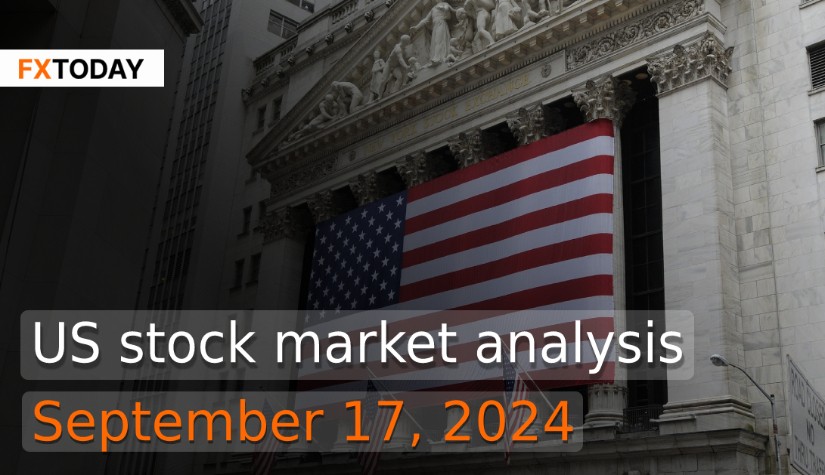Wall Street Gains on Tech and AI, Fed Rate Cut Uncertainty Clouds Market
Last week, Wall Street saw significant gains, driven by strong technology stock performance and renewed interest in artificial intelligence. The S&P 500 rose 4%, the Dow climbed 2.6%, and the Nasdaq surged nearly 6%, though it remained below earlier peaks.
U.S. stocks showed mixed results on Monday as investors remained cautious ahead of an upcoming Federal Reserve meeting, where a rate-cutting cycle is anticipated to begin. The Dow Jones Industrial Average rose by 228 points (0.55%), reaching a record high, while the S&P 500 saw a modest 0.1% increase. In contrast, the Nasdaq Composite dropped by 90 points (0.51%).
The market was also affected by news of an attempted assassination on Republican presidential candidate Donald Trump. In Monday evening trades, technology stocks lost momentum, but investors shifted focus to economically sensitive sectors, helping the Dow reach record levels.
Among notable corporate moves, Intel surged over 7% after announcing plans to spin off its foundry business and sell part of its stake in Altera. Intel also reported a deal with Amazon Web Services for custom chip manufacturing. Meanwhile, Microsoft shares saw a slight increase following a $60 billion stock buyback announcement and a dividend hike. Other movers included Pfizer, whose stock rose after promising drug trial results, while Boeing shares dropped amid an ongoing worker strike.
The Federal Reserve is expected to cut rates after its two-day meeting concludes on Wednesday. This uncertainty contributed to recent market volatility, although both the S&P 500 and the Dow remained near record highs.
Despite inflation and labor market concerns, the Fed is anticipated to continue easing rates in the coming months. The futures market for federal funds is now pricing in nearly a 60% chance of a 50 basis-point rate cut by the Federal Reserve, a significant shift from earlier expectations, which saw only a 25% probability last week. This reflects rising anticipation that the Fed may take more aggressive action to lower borrowing costs, as reports and comments from influential figures like former New York Fed President Bill Dudley have highlighted the need for a larger cut to realign interest rates with the Fed’s dual mandate of price stability and employment. Dudley’s argument, that current short-term rates remain well above neutral, underscores a growing sense that monetary policy may be overly restrictive, especially given signs of economic cooling.
The significance of whether the Fed opts for a 25 or 50 bps cut lies not just in the immediate economic effect, but in what it signals to investors about the Fed’s view of the economy. A 50 bps cut could indicate that the Fed is more concerned about recession risks than previously thought. A larger cut might suggest the Fed sees deeper issues on the horizon, while a smaller cut would imply more confidence in the economy's resilience.
In broader terms, the Fed’s impending decision represents a pivotal moment for financial markets. Historically, the performance of stocks, bonds, and the dollar after the start of a rate-cutting cycle has been heavily influenced by the underlying health of the economy. For instance, when cuts happen during a recession, stocks often struggle, as seen with an average 4% drop in the S&P 500 over the six months following the first rate cut during recessionary periods. Conversely, non-recessionary cuts typically lead to more favorable outcomes, with the S&P 500 gaining an average of 14%.
The performance of bonds and the dollar is also closely tied to the economic outlook. Treasuries have traditionally been a safe haven during recessions, with yields falling alongside rate cuts. However, without a hard landing, the room for further bond rallies could be limited, as current Treasury yields have already fallen significantly. This uncertainty leaves investors in a precarious position, where gains may be constrained unless the economy falters more sharply.
Looking forward, the key challenge for investors will be determining whether the Fed’s actions are timely enough to prevent a deeper economic downturn. While some remain optimistic that the Fed can engineer a "soft landing," where rate cuts stimulate growth without triggering a recession, others are wary of the numerous "tectonic risks" facing the market, including political uncertainty, global tensions, and sluggish economic data.
Data for Technical Analysis (1H) CFD US30 DJIA
Resistance : 41606.4, 41616.1, 41631.8
Support : 41575.0, 41565.3, 41549.6
1H Outlook
Source: TradingView
Buy/Long 1 If the support at the price range 41525.0 - 41575.0 is touched, but the support at 41575.0 cannot be broken, the TP may be set around 41607.4 and the SL around 41500.0, or up to the risk appetite.
Buy/Long 2 If the resistance can be broken at the price range of 41606.4 - 41656.4, TP may be set around 41680.0 and SL around 41550.0, or up to the risk appetite.
Sell/Short 1 If the resistance at the price range 41606.4 - 41656.4 is touched, but the resistance at 41606.4 cannot be broken, the TP may be set around 41566.3 and the SL around 41681.4, or up to the risk appetite.
Sell/Short 2 If the support can be broken at the price range of 41525.0 - 41575.0, TP may be set around 41495.0 and SL around 41631.4, or up to the risk appetite.
Pivot Points Sep 17, 2024 01:39AM GMT
|
Name
|
S3
|
S2
|
S1
|
Pivot Points
|
R1
|
R2
|
R3
|
|---|---|---|---|---|---|---|---|
| Classic | 41525.2 | 41549.6 | 41566.3 | 41590.7 | 41607.4 | 41631.8 | 41648.5 |
| Fibonacci | 41549.6 | 41565.3 | 41575 | 41590.7 | 41606.4 | 41616.1 | 41631.8 |
| Camarilla | 41571.8 | 41575.6 | 41579.3 | 41590.7 | 41586.9 | 41590.6 | 41594.4 |
| Woodie's | 41521.4 | 41547.7 | 41562.5 | 41588.8 | 41603.6 | 41629.9 | 41644.7 |
| DeMark's | - | - | 41558 | 41586.6 | 41599.1 | - | - |
Sources: Investing 1, Investing 2
















